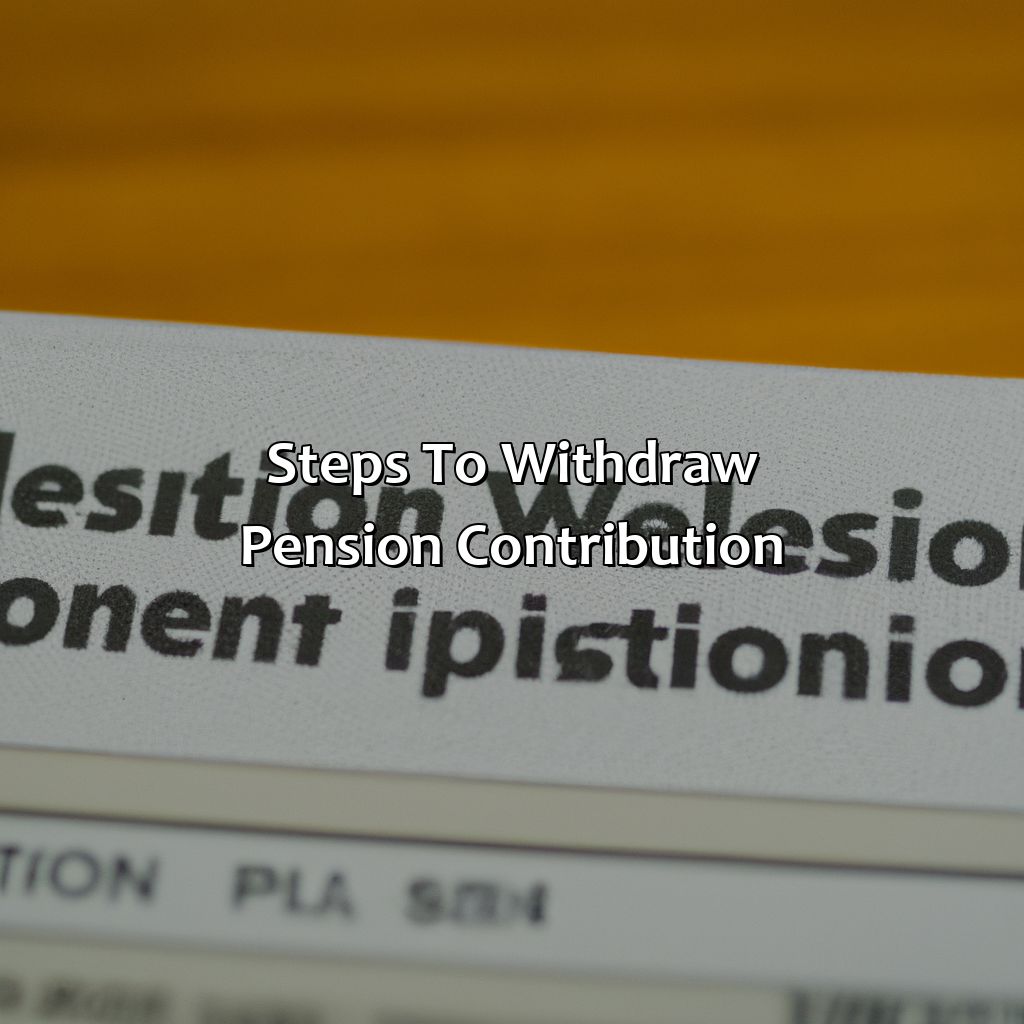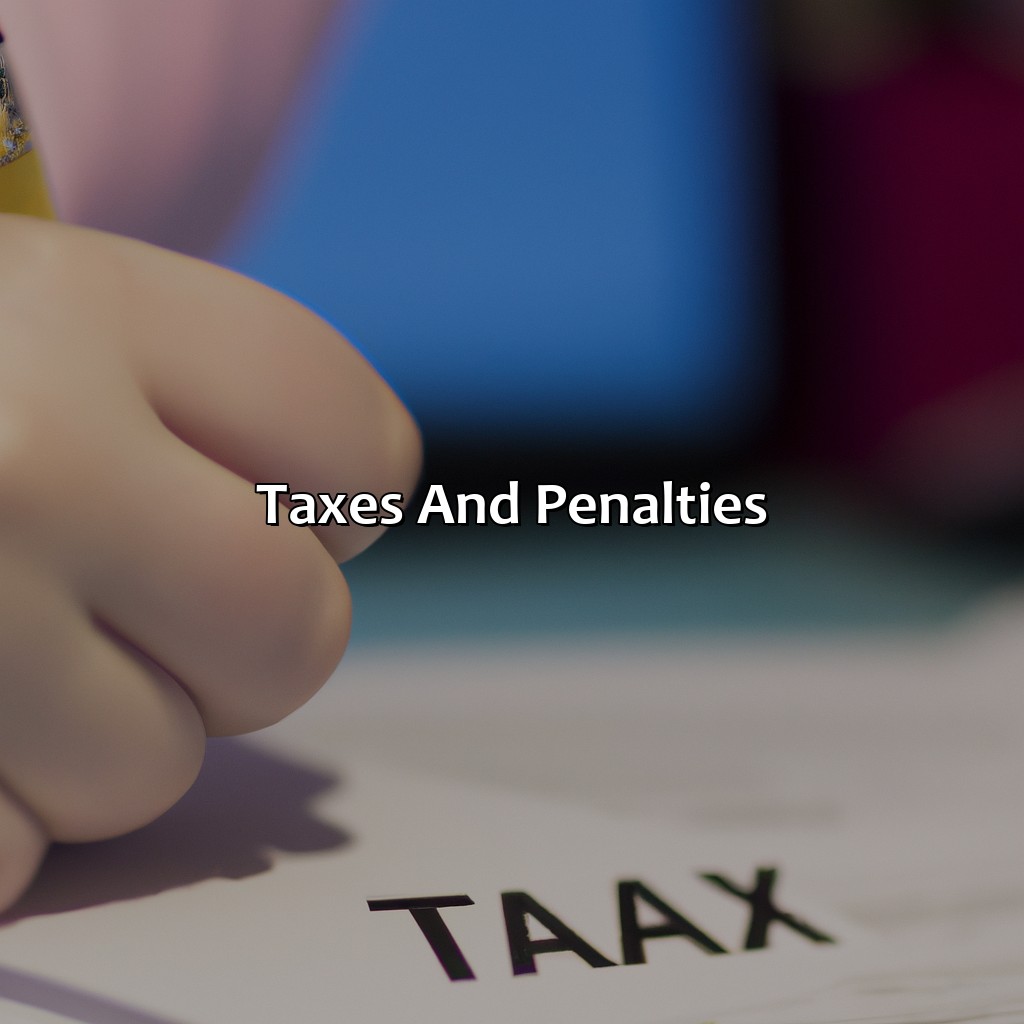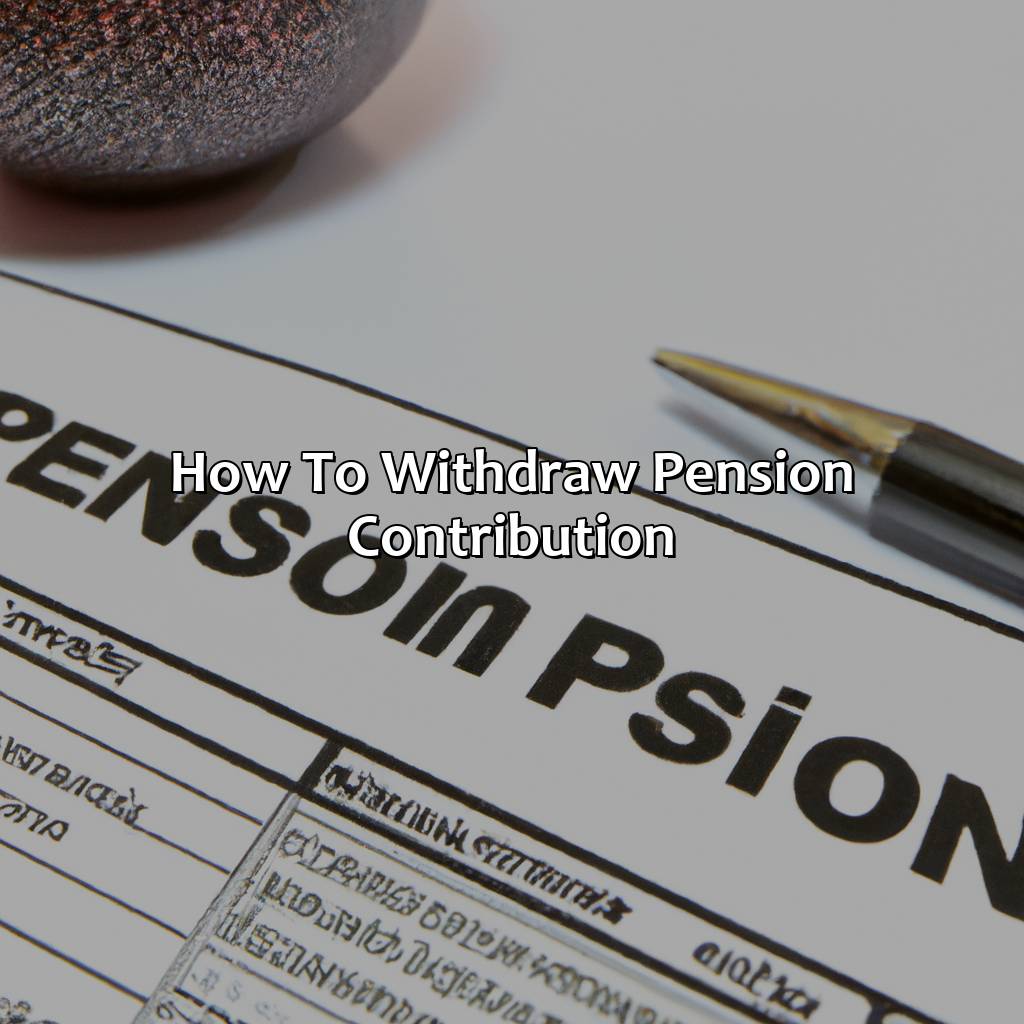How To Withdraw Pension Contribution?
Key Takeaway:
- There are two types of pension plans: defined benefit and defined contribution. Defined benefit plans provide a fixed benefit amount, while defined contribution plans rely on the individual’s contributions and investment earnings.
- To withdraw pension contributions, one must meet certain eligibility criteria and provide required documents, such as proof of identification and employment history. The type of withdrawal can either be a lump sum or an annuity, depending on individual preference.
- Withdrawals from pension plans may have tax implications and early withdrawal penalties. However, alternatives such as borrowing against the plan or taking a loan may be available.
Feeling confused about withdrawing your pension contributions? You don’t need to stress – this article will guide you through the process step-by-step. Withdrawing your pension can help ensure your long-term financial security, so it’s important to approach this decision in a planned and strategic way.
Types of Pension Plans
The Different Categories of Pension Plans. Investing in a pension plan is crucial for building a secure future, but with many options available, it can be confusing to choose. Here are the various types of pension plans that cater to different needs.
| Type of Pension Plan | Description |
| Defined Benefit Plan | A traditional plan where the employer guarantees a specified retirement payout based on years of service and salary |
| Defined Contribution Plan | An individual plan where employee and/or employer contribute to an account where investment returns determine the retirement payout |
| Cash Balance Plan | A hybrid of the defined benefit and defined contribution plans where the employer credits a set amount to the employee s account each year |
While the defined benefit plan was the norm in the past with guaranteed payouts, many companies have shifted towards defined contribution plans due to the lack of financial risk and cost savings. Individuals also have the option of opening an individual retirement account (IRA) to invest in for retirement.
Pension plans have been around since ancient Rome where soldiers would receive pensions for their service. The concept of employer-sponsored pension plans started in the late 1800s with American Express Company introducing a plan for its employees.

Image credits: retiregenz.com by David Jones
Steps to Withdraw Pension Contribution
Withdrawing pension contributions? Follow these steps!
Eligibility criteria, required docs and types of withdrawal (lump sum or annuity) – all yours for the taking. Get started now!

Image credits: retiregenz.com by Yuval Arnold
Eligibility Criteria for Pension Withdrawal
Withdrawal of pension contributions is possible only if an individual meets the eligibility norms set by the governing body. Eligibility criteria for pension withdrawal vary from one country to another. To qualify, one must have reached the age limit specified by the government and meet other terms as regarding employment history, payment records, etc. The process demands valid identification and verification documents, such as a birth certificate or identity card and work records that indicate their contributions record accurately.
Furthermore, individuals who leave their employment before retirement may be eligible for early pension withdrawal if they meet specific parameters. Such parameters may often include medical conditions that necessitate medical retirement or redundancy caused by business closure or downsizing. If you’re wondering how can I claim my pension back, you should consult with a financial advisor who can guide you through the process.
In fact, recent research indicates that it is becoming increasingly common for young employees to cash out their pensions made so far to cater to immediate needs in rare cases of need like purchasing a house or emergency medical needs. However, such events result in loss of income streams later on in life. Hence it’s important not to be tempted by short-term gains and jeopardize long-term financial stability.
One incident worth mentioning is that of a government employee in the United States who attempted money laundering through withdrawing their entire accumulation worth $200000 from his pension account. However, local law enforcement agencies caught him following thorough investigation into his bank transfers ultimately resulting in arrest and hefty punishment.
Getting your hands on all these documents might make you feel like you’re trying to take on the government single-handedly. Good luck!
Required Documents
To complete the pension contribution withdrawal process, certain documents are required. These documents govern and validate the claimant’s identity and authorization to withdraw such a sum.
- Proof of identity – This must include either a valid passport or national ID card.
- Bank statement – A verified bank account that can receive the transferred funds.
- Pension Withdrawal Form – The completed pension form provided by the relevant authority.
It is essential to note that different countries have varying regulations regarding pension withdrawals, so ensure you verify which documents are necessary for your region.
Pro Tip: Double-check all mentioned requirements before submitting the documents to avoid unnecessary delays in the pension withdrawal process.
Choosing between a lump sum and annuity withdrawal is like deciding whether to binge-watch Netflix or invest in a gym membership – both have their benefits, but one might leave you with regrets.
Types of Withdrawal (Lump Sum or Annuity)
When it comes to taking out your pension contributions, there are two main options available: lump sum or annuity. Depending on your personal financial situation and goals, you may choose one over the other. The following table describes the two withdrawal types:
| Withdrawal Type | Description |
| Lump Sum | A one-time payment that provides immediate access to your pension savings |
| Annuity | A series of periodic payments that provides a steady income stream over time |
It is important to note that with an annuity, you may have less control over how the payments are distributed and when they will end. However, an annuity can provide a more predictable income stream in retirement. Consider discussing your individual circumstances with a financial advisor before making any big decisions about withdrawing your pension contributions. As always when dealing with finances, it is essential to do your research and gather all necessary information before making any decisions. Though deciding how to withdraw your pension contributions can seem overwhelming at first, take comfort in knowing you have options and resources to help guide you through the process. Remember, taking action now could prevent future regrets down the line. Make an appointment with a financial advisor today to discuss what course of action is best for you and help ensure a secure retirement. Good news: Withdrawing your pension contribution means less taxes in your paycheck! Bad news: You’ll still have to face the penalty of realizing you’re getting older.
Taxes and Penalties
Navigating the complexities of taxes and penalties related to pension withdrawal? Head to the Taxes and Penalties section.
It has info on How To Change Your Pension Bank Account, Tax Implications, Early Withdrawal Penalty and Alternatives to Pension Withdrawal.
Ready to explore?

Image credits: retiregenz.com by Harry Arnold
Tax Implications of Pension Withdrawal
The consequences of withdrawing pension contributions can lead to hefty tax penalties. The taxation amount is dependent upon the investor’s age, income, and the terms associated with their retirement plan or annuity. It’s crucial to seek financial advice before making any premature withdrawals.
Additionally, early withdrawal from pension schemes such as 401ks or IRAs may result in a ten percent penalty payment, in addition to federal taxes throughout the process. Conversely, qualified withdrawals made after fifty-nine and a half years old are subject to regular tax rates without penalty fees.
In addition to tax implications, investors who withdraw earlier than expected may encounter irreversible reductions in their retirement savings’ account value due to taxes and early termination penalties. Individuals should evaluate these losses carefully when considering an early withdrawal from their pension fund.
Mississippi teacher Tammy Puzzo found herself in dire financial straits amid a divorce process that caused her job loss. She had begun her teaching career at twenty-two years old and invested regularly into a defined benefit pension plan. Unfortunately, Tammy chose to take a cash lump sum payout instead of roll it over into an IRA when offered by her employer at forty-seven years old. As a result of this decision, she was forced into an increased income tax bracket with no other means for reducing it, ultimately forcing her into bankruptcy.
If you want to avoid such circumstances, it’s important to know how to open a new pension scheme account and properly manage your pension contributions over the course of your career.
Making an early withdrawal from your pension contribution is like trying to cut off your nose to spite your face, except with taxes and penalties instead.
Early Withdrawal Penalty
Withdrawing your pension contribution early can result in a penalty. This is a fee applied by the government to discourage people from taking out their pensions before reaching retirement age. The penalty may vary depending on the type of pension, the amount withdrawn and your age.
It’s important to note that there may also be tax implications when withdrawing early, such as incurring income tax or losing tax relief on future contributions. Therefore, it’s crucial to speak with a financial advisor before making any decisions regarding how to transfer your pension.
Additionally, some exceptions apply to early withdrawals where penalties may not be enforced, such as serious ill-health or terminal illness. Still, even in these circumstances, there may be restrictions and limitations on how much you can withdraw. If you are wondering when pension can be withdrawn, it’s important to understand these exceptions and limitations.
According to the Office of National Statistics, nearly one in three people who withdraw money from their pensions do so without seeking professional advice. It’s essential to consult with experts who can help navigate complex rules and ensure better outcomes for your retirement savings.
Alternatives to Pension Withdrawal
Pension Contribution Withdrawal Alternatives
There are numerous ways to manage your pension contribution aside from withdrawing it.
- Consider taking a pension loan.
- Transfer your pension funds into another scheme.
- Alter your regular contributions rate.
- Convert part of your pension plan into an annuity.
- Think about early retirement options.
- Snowball payments to contribute an increased sum on the original plan.
Additionally, some employers offer options such as phased retirement or partial drawdown that could help explore fresh opportunities.
Unique Additional Notes
There is also one crucial option left: social investments. These alternative investments in environmental, social and governance issues can benefit from a favorable tax treatment for pensions in some countries. If you want to know how to apply for pension credits, you can visit our website for more information.
An Empathetic True Story
Susan, 65 years of age and retired, discovered her cancer diagnosis after a decade of contributing to her pension fund. Susan needed to finance her therapy through something other than her savings, but she was afraid that the removal of substantial sums would incur additional costs from taxes and penalties. A financial advisor introduced her to “phased withdrawal” withdrawals instead; where specific amounts of funds would be withdrawn each year which did not breach SUSAN’S personal income threshold limit. Due to monthly payment approvals established within the procedure; safeguarding her standard living expenses wasn’t affected either while managing and financing cancer treatments simultaneously.
Five Facts About How To Withdraw Pension Contribution:
Pension contributions can typically be withdrawn starting at age 55. (Source: Money Advice Service)
The amount that can be withdrawn tax-free depends on individual circumstances, such as income and pension scheme type. (Source: Gov.uk)
Withdrawing pension contributions can impact future pension income and may not be the best option for everyone. (Source: The Telegraph)
There are several options for withdrawing pension contributions, including taking a lump sum, buying an annuity, or entering into a flexible income drawdown plan. (Source: Money Helper)
Seeking guidance from a financial adviser can help individuals make informed decisions about withdrawing pension contributions. (Source: Money Advice Service)
FAQs about How To Withdraw Pension Contribution?
How can I withdraw my pension contribution?
To withdraw your pension contribution, you need to contact your pension provider and request a withdrawal form. You will then need to fill out this form and send it back to your pension provider.
Can I withdraw my pension contribution even if I’m not retired yet?
It depends on your pension plan. Some plans allow for early withdrawal, but others do not. You should check with your pension provider to find out their specific rules and regulations.
Is there a penalty for withdrawing my pension contribution early?
Yes, there is usually a penalty for early withdrawal of pension contributions. The penalty amount will vary depending on your pension plan and the amount of money you are withdrawing. You should ask your pension provider about the penalties associated with early withdrawal.
Can I withdraw a portion of my pension contribution, or do I have to withdraw it all?
You may be able to withdraw a portion of your pension contribution, depending on your pension plan. Some plans allow for partial withdrawals, while others require you to withdraw the entire amount. You should check with your pension provider to find out their specific rules and regulations.
How long does it take to receive my pension contribution after I submit a withdrawal request?
The processing time for pension withdrawal requests can vary depending on your pension plan and your provider. Some providers may process withdrawals within a few days, while others may take several weeks or even months. You should contact your pension provider to find out how long you can expect to wait for your withdrawal.
What taxes will I need to pay when I withdraw my pension contribution?
The amount of taxes you will need to pay when you withdraw your pension contribution will depend on a variety of factors, such as your income level and tax bracket. You should consult with a tax professional to determine how much you can expect to pay in taxes on your withdrawal.
 Checkout this IRS Loophole
Checkout this IRS Loophole 
